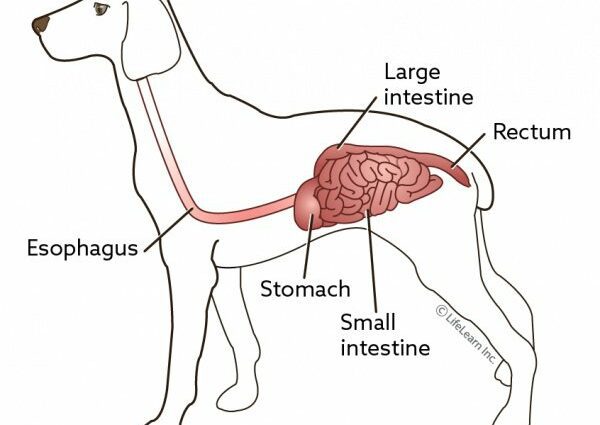Contents
Constipation of the dog: my dog is contipated, what to do?
Digestive disorders are one of the reasons for frequent consultation in our pets. Of these, constipation easily affects the quality of life of dogs who suffer from it. It can then be tempting to find solutions at home to make their transit more fluid. However, the causes of constipation are varied and a veterinary diagnosis may be necessary. What to do if your dog is constipated?
Recognize a constipated dog
By definition, constipation is the decrease in the frequency and quantity of stools. It is often accompanied by difficulty or pain during defecation. Stools can be small or look very dry.
A constipated dog will get into position many times, strain with abdominal contractions, and may show signs of pain. Traces of blood may be visible on the stool.
As with cats, signs of difficulty in passing a bowel movement are very similar to signs of difficulty in urinating. Make sure your dog is urinating properly if you see him getting into position regularly. If in doubt, do not hesitate to contact your veterinarian. Difficulty urinating is a reason for emergency management.
The main causes of constipation in dogs
The set of causes that can cause constipation is vast and varied.
First of all, the way of life greatly influences the transit of our animals. There are thus predisposing factors that are often found in animals presented in consultation for constipation:
- Sedentary lifestyle and obesity: sufficient regular activity helps to maintain correct transit. Thus overweight and not very active animals are more easily affected by constipation;
- Age: For several reasons, constipation more often affects older animals.
In dogs, constipation is mainly due to food causes. There are other pathologies that will disrupt or block the emission of stool.
Food cause
- Insufficient water intake: a correct state of hydration is important to avoid the formation of dry stools which evacuate more difficult;
- Foreign body: Many dogs tend to make what is known as food pica. That is, chewing on and partially ingesting solid, poorly digestible objects such as bones or wood. In the event of heavy ingestion, these objects can slow down transit or even create intestinal obstructions..
Anal or perianal injury
Several pathologies will cause pain localized in the annal region during emunctory efforts which leads to reluctance to go to the stool: for example an abscess of the anal glands or perianal fistulas.
Mechanical obstruction
Other pathologies will lead to a decrease in the diameter of the intestine and limit the passage of stool. In uncastrated male dogs, prostatic disease is a common cause of constipation.
Although more rare in dogs, constipation can also occur following general pathologies which will affect the functioning of the digestive tract: certain neurological disorders, colonic distension for example.
Do not delay in seeing if your dog is constipated
If you have the impression that your dog is constipated, it is important not to wait too long before presenting him to your veterinarian. Only a complete clinical examination will determine the cause of the constipation in order to implement an appropriate treatment.
Diagnostic
To determine the cause of constipation, your veterinarian will perform a complete clinical examination of your dog. A digital rectal exam is often done to assess the presence of an annular or rectal lesion.
If necessary, he will suggest additional examinations (x-rays, blood tests) to assess the severity of the constipation or to certify the presence of an underlying disease.
For simple cases, oral or rectal medical treatment may be sufficient.
For more advanced cases, hospitalization with an infusion to rehydrate the animal may be necessary.
Some tips to improve your dog’s transit
If you know the cause of his constipation, there are several easy solutions you can take to improve your dog’s transit.
- Increase the water intake in his ration: increasing the proportion of wet food in the ration will help to thin the stool and facilitate their evacuation. You can also resort to boiled vegetables to mix with his diet. In addition to providing water, these vegetables provide fiber which promotes transit: zucchini or pumpkins are good examples;
- Increase activity: walks, games. Remember to offer regular and sufficient activities for your dog;
- Monitor his weight: assess your dog’s build with your veterinarian and discuss solutions together to limit or even gradually reduce his weight if necessary.
- Food and treatments to facilitate transit: some brands offer ranges of hyperdigestible foods. These foods are formulated to limit the amount of stool formed after digestion and therefore reduce the risk of constipation;
- It is also possible to administer oral treatments: for example laxatives based on paraffin oil make it possible to lubricate the stool in the digestive tract.
Ask your vet for advice on using the right treatment for your dog.
Conclusion
In dogs, constipation can be due to eating disorders but also to more profound pathologies. It is important to see your veterinarian if your dog is showing signs of constipation. This consultation will make it possible to find the cause of the condition in order to set up the appropriate treatment. However, solutions exist to improve the transit of your companion in the long term if the cause of the constipation is known.










